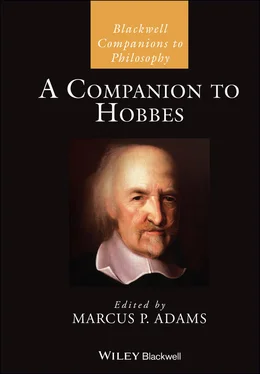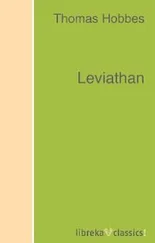the definition is nothing but a resolution of that name into its most universal parts. As when we define man, saying man is a body animated , sentient , rational , those names, body animated , & c . are parts of that whole name man ;
(EW I.83)
But how does such an analysis into abstract terms, which combine to form definitional propositions, explain persons in the world, as experienced by us?
Since accidents are both the manner in which we conceive bodies, and the faculties by which bodies produce these conceptions in us, explanations of names obtained by resolution map on to bodily powers via the conceptual parts of ideas to which abstract names attach. 24The strictly analytical method gives us the definitions of things by separating out the conceptual parts, or explanatory factors that make up our complex ideas of individuals. That is, the abstract name “humanity” is a sign for a conception of an individual body that can be resolved into accidents of being animated and being rational. Via similarity to past ideas of such bodies the abstract names of “animality” and “rationality” attach to these conceptual parts. This allows us to compound these names into propositions, including universal ones like “Every human is a rational animal.” Hobbes claims that, without words, specifically, abstract names that stand as markers to remind us of past ideas of similar individuals, “our inventions perish, nor will it be possible for us to go on from principles beyond a syllogism or two, by reason of the weakness of the memory” (EW I.79). Employing the universal method, one combines abstract names into propositions by synthesis.
The particular method is instead a method of demonstration in which one employs synthesis2 to connect propositions by the rules for a valid syllogism. For example, from one’s definition of humanity one can deduce a consequence of rationality that is fundamental to civil science:
All human beings are rational animals.
Rationality includes the capacity to make compacts.
Therefore, human beings have the capacity to make compacts.
Hobbes ambiguously uses the terms “computation” and “synthesis” for both the process of methodically compounding the results of strict analysis into definitions, as well as the deductions by which we later connect propositions into syllogisms to answer particular questions. However, properly speaking, scientific knowledge involves syllogistic computation. The analysis and synthesis by which one arrives at definitions is preparatory to natural and moral science. The main feature of universal method for unqualified scientific knowledge is that the analysis of ideas/concrete names and combination of conceptual elements into definitions must proceed in the correct order, so that we resolve step by step from the most complex and particular, to the simplest and most universal ones until we arrive at the most universal explanatory factor signified by the abstract term “motion.” We then synthesize definitions following the reverse order. Provided we know where on this hierarchy the definitions relevant to a particular inquiry are located, we can take short cuts when applying particular method. 25The hierarchically ordered definitions attained by Hobbes’s method for unqualified scientific knowledge supply the principles one deduces from in particular method. The latter can be analytic2, synthetic2 or a combination of both. In the methodical pursuit of particular scientific inquiries, computation is not the generation of ordered definitions that follows analysis into universal notions but fits Hobbes’s identification of scientific knowledge with deductive reasoning.
This is clear from Hobbes’s example of using analysis2 and synthesis2 to inquire after the subject of an accident. 26The question is: In what subject is the splendor and apparent magnitude of the sun? The methodical steps are:
1 Analysis2: matter in general [materia universa] is divided into parts, e.g., object, medium and sentient or “by some other division which seems most suitable to the proposed matter [rem]” (EW I.76).
2 Synthesis2: “Next, the individual parts are to be examined according to the definition of the subject; and those which are not capable of those accidents are to be rejected” (EW I.76).For example, we rule out the body of the sun as the subject by discovering that the sun is greater than its apparent magnitude and hence that magnitude is not in the sun; we discover this through knowledge of optics:“if the sun be in one determined straight line, and one determined distance, and the magnitude and splendor be seen in more lines and distances than one, as it is in reflection and refraction, then neither that splendour nor apparent magnitude are in the sun itself, and, therefore, the body of the sun cannot be the subject of that splendour and magnitude” (EW I.76).We rule out the air and other parts by the same reasons until we are left with the sentient as the subject of the splendor of the sun.
Synthesis2 is not an aggregation of concepts/names into definitions but a methodical use of prior definitions that universal method orders as more basic (like principles of optics) and other bits of prior knowledge to narrow down possibilities and deduce the correct conclusion. 27Physicists may require observations to exclude some possibilities whereas geometers or civil scientists may employ constructions and thought experiments before making deductions. These are differences in application, not in the essence of the particular method.
In this chapter, I have argued that Hobbes’s philosophical method is integral to his project of separating philosophy and religion so as to put morals on a true scientific foundation. I have clarified what Hobbes means by “science,” “method,” and “demonstration,” showing that the common attribution of a mechanistic method of resolution to Hobbes is incorrect. Building on recent views regarding whether Hobbes has a unified method for theoretical and practical philosophy I add to available interpretations by drawing on Hobbes’s context. Like contemporaneous methods, Hobbes’s method comprises a universal and a particular method. This distinction sheds light on how analysis and synthesis function in each branch of Hobbes’s method in a way that serves to unify and place both theoretical and practical philosophy on a scientific basis.
1 Adams, Marcus P.2014. Mechanical Epistemology and Mixed Mathematics: Descartes’s Problems and Hobbes’s Unity. PhD diss., University of Pittsburgh.
2 Adams, Marcus P.2017. “Natural Philosophy, Deduction, and Geometry in the Hobbes-Boyle Debate.” Hobbes Studies 30: 83–107.
3 Adams, Marcus P.2019. “Hobbes’s Laws of Nature in Leviathan as aSynthetic Demonstration: Thought Experiments and Knowing the Causes.” Philosopher’s Imprint 19 (5): 1–23.
4 Aristotle. 1984. “Nicomachean Ethics.” In The Complete Works of Aristotle, Vol. II, edited by Jonathan Barnes. Princeton: Princeton University Press.
5 Blancanus, Josephus. 1996. “De Mathematicarum Natura Dissertatio, Appendix to Aristotelis Loca Mathematica. Translated by Gyula Klima.” In Philosophy of Mathematics and Mathematical in the Seventeenth Century,edited by Paolo Mancosu, 178–212. New York: Oxford University Press.
6 Burgersdijk, Franco. 1626. Institutionum Logicarum Libri Duo. Leiden: Apud Abrahamum Commelinum.
7 Duncan, Stewart. 2003. Hobbes: Metaphysics and Method. PhD diss., Rutgers University.
8 Gabbey, Alan. 1993. “Descartes’s Physics and Descartes’s Mechanics: Chicken and Egg?” In Essays on the Philosophy and Science of Descartes, edited by Stephen Voss , 311–23. Oxford: Oxford University Press.
Читать дальше












